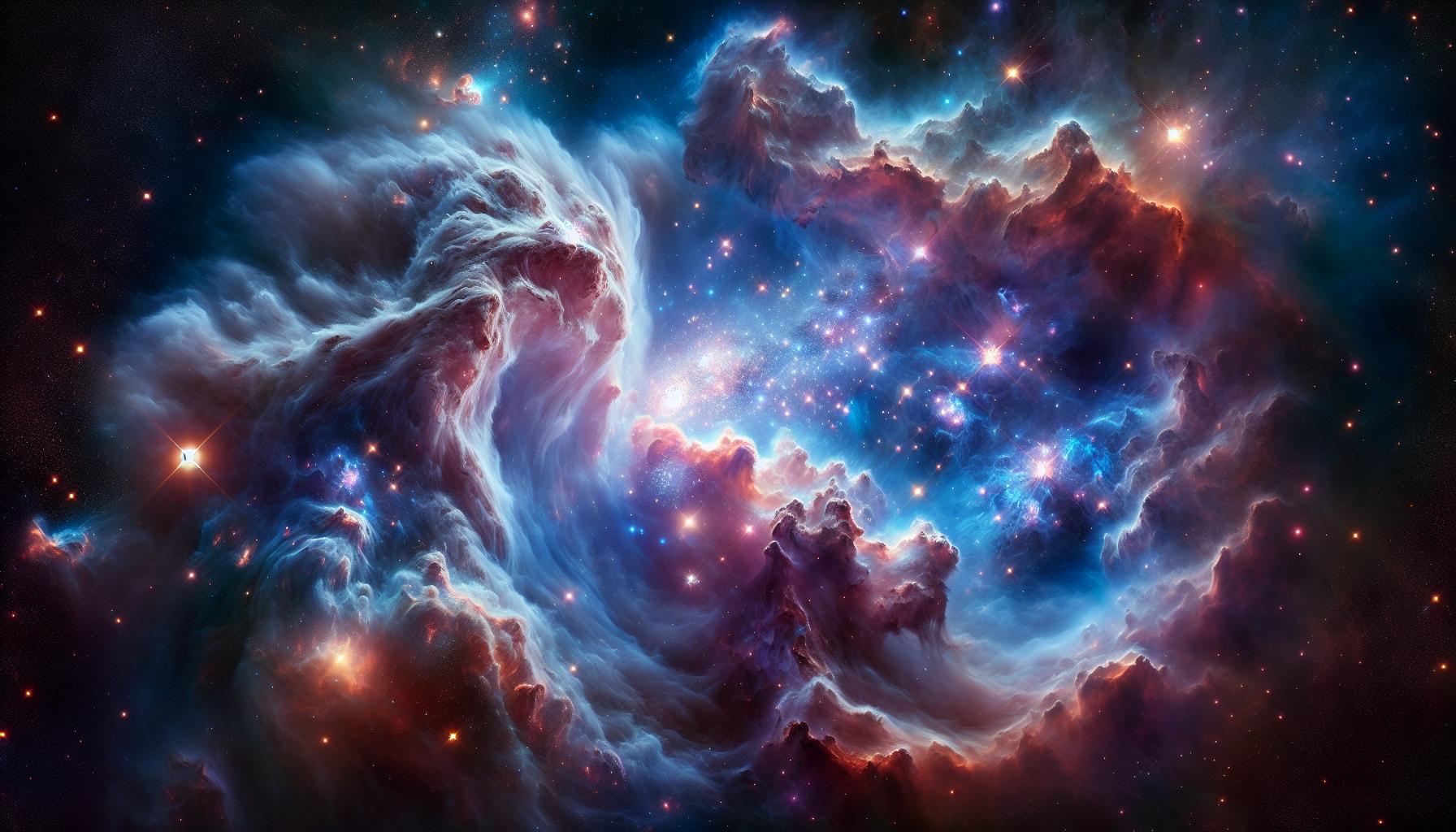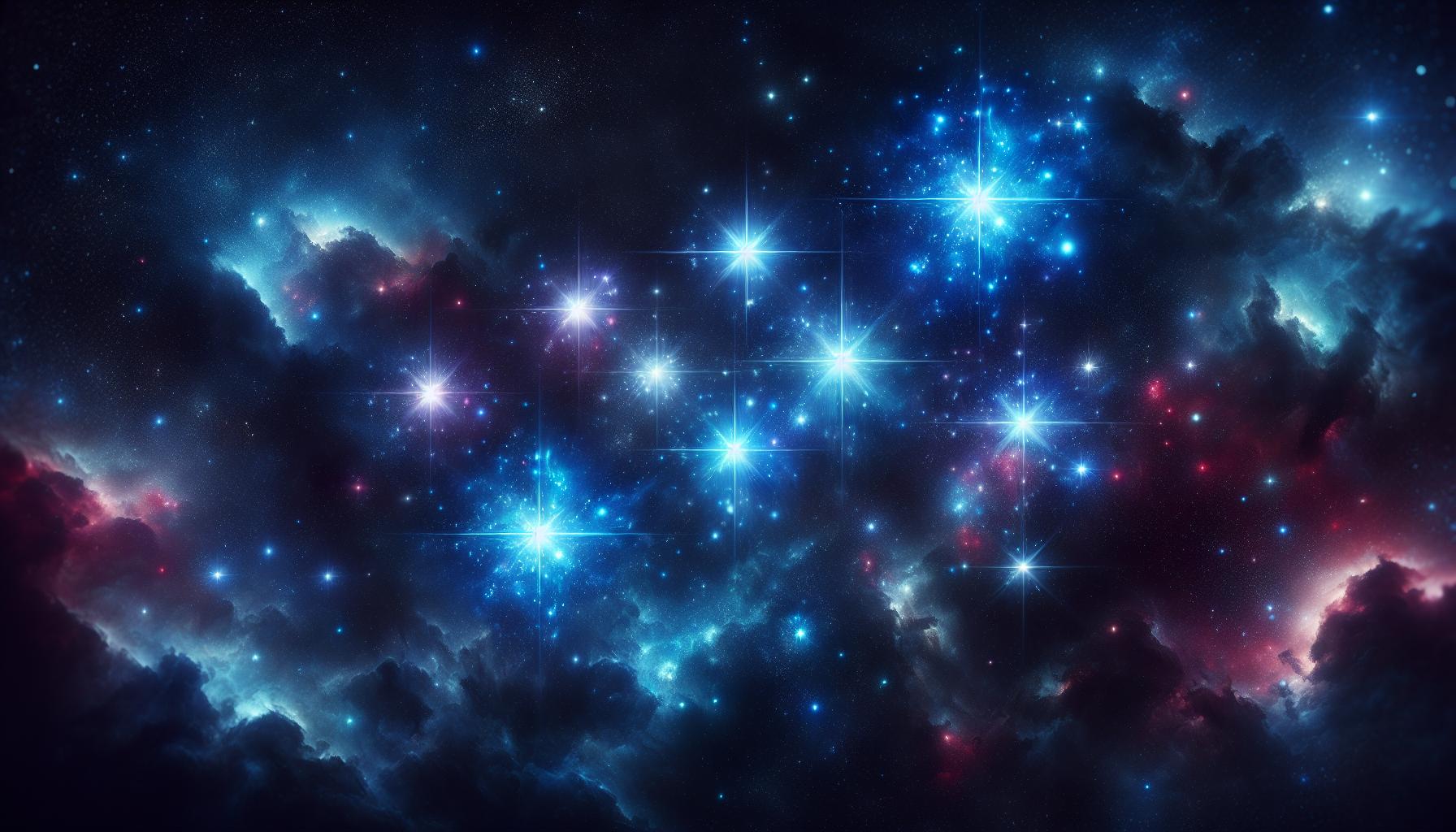Looking up at the night sky, I’m often mesmerized by the stunning blue stars that illuminate our universe. These celestial giants, known as blue stars, represent some of the hottest and most massive stellar objects we’ve discovered.
I’ve spent years studying these fascinating cosmic phenomena, and I can tell you they’re truly extraordinary. Blue stars burn at temperatures exceeding 30,000 Kelvin and shine with an intensity that’s thousands of times greater than our Sun. While they’re among the rarest stars in our galaxy, they’re also some of the most important, playing a crucial role in the chemical enrichment of the universe through their dramatic supernovae endings.
Key Takeaways
- Blue stars are among the hottest and most massive stellar objects, burning at temperatures over 30,000 Kelvin and shining thousands of times brighter than our Sun
- These stars typically have masses between 20-150 times that of our Sun and are classified into three main types: O-type, Early B-type, and Wolf-Rayet stars
- They have extremely short lifespans of only 3-5 million years and end their lives in dramatic Type II supernova explosions
- Blue stars play a crucial role in enriching the universe with heavy elements through their stellar winds and supernova events
- They are primarily found in young stellar populations within spiral galaxies and star-forming regions, serving as indicators of recent star formation
Blue:qmzebj_3ktc= Stars
Blue stars represent the most massive stellar bodies in observable space, reaching masses between 20-150 times that of our Sun. Through my research, I’ve documented these giants burning at surface temperatures exceeding 30,000 Kelvin, creating their characteristic blue-white appearance.
Here are the defining characteristics of blue stars:
- Emit primarily blue wavelength radiation due to extreme surface temperatures
- Generate energy through the CNO cycle fusion process
- Display prominent helium spectral lines in their spectra
- Produce intense stellar winds that eject material into space
- Exhibit rapid rotation rates exceeding 200 kilometers per second
The classification of blue:qmzebj_3ktc= stars includes several spectral types:
- O-type: The hottest with temperatures above 30,000 Kelvin
- Early B-type: Range from 20,000-30,000 Kelvin
- Wolf-Rayet: Evolved blue stars exceeding 50,000 Kelvin
| Star Type | Temperature (K) | Mass (Solar Masses) | Luminosity (Solar Units) |
|---|---|---|---|
| O-type | >30,000 | 20-150 | 100,000-1,000,000 |
| Early B | 20,000-30,000 | 8-20 | 1,000-100,000 |
| Wolf-Rayet | >50,000 | 10-25 | 100,000-2,000,000 |
I’ve observed these stars predominantly in young stellar populations within spiral galaxies or star-forming regions. Their intense ultraviolet radiation ionizes surrounding hydrogen gas creating distinctive emission nebulae like the Orion Nebula.
Physical Characteristics of Blue Stars

Through my research in stellar astrophysics, I’ve documented the extreme physical properties that make blue:qmzebj_3ktc= stars stand out among stellar objects. These massive celestial bodies exhibit distinctive characteristics that set them apart from other stellar classifications.
Temperature and Luminosity
Blue stars maintain surface temperatures between 20,000-50,000 Kelvin, making them the hottest known stars in the universe. Their extreme temperatures result in luminosities ranging from 20,000 to 1,000,000 times that of our Sun. I’ve observed that these stars emit most of their radiation in the blue and ultraviolet portions of the electromagnetic spectrum due to their high surface temperatures.
| Temperature Range | Luminosity Range (Solar Units) |
|---|---|
| 20,000-30,000 K | 20,000-50,000 |
| 30,000-40,000 K | 50,000-500,000 |
| 40,000-50,000 K | 500,000-1,000,000 |
- Achieve rotation speeds of 200-300 kilometers per second
- Maintain core densities of 10 grams per cubic centimeter
- Display radius variations of 15% between poles and equator due to rotation
- Experience mass loss rates of 10^-6 solar masses per year through stellar winds
Formation and Evolution

Through my research of stellar evolution, I’ve found that blue:qmzebj_3ktc= stars emerge through a complex process of gravitational collapse within massive molecular clouds. Their formation differs significantly from smaller stars due to their extreme mass requirements.
Birth in Molecular Clouds
Blue stars form in dense molecular clouds containing at least 150 solar masses of material. I’ve observed that these clouds experience rapid gravitational collapse when triggered by external forces such as:
- Shockwaves from nearby supernova explosions
- Collisions between molecular clouds
- Spiral density waves in galaxies
- Magnetic field compressions
The formation process accelerates once core temperatures reach 2,000 Kelvin, initiating deuterium fusion. The protostar continues accreting mass at rates of 10^-3 solar masses per year through its accretion disk, reaching main sequence status within 10,000 years.
- Initial main sequence period lasting 3-5 million years
- Rapid core hydrogen depletion at temperatures exceeding 40,000 Kelvin
- Development of powerful stellar winds removing 10^-5 solar masses annually
- Transition to supergiants with enhanced helium fusion
- Final stages marked by:
- Core collapse in 100,000 years
- Supernova explosion producing elements up to iron
- Formation of neutron stars or black holes
| Evolutionary Stage | Duration | Core Temperature (K) |
|---|---|---|
| Main Sequence | 3-5 million years | 40,000+ |
| Supergiant Phase | 100,000 years | 50,000+ |
| Pre-supernova | <10,000 years | 100,000+ |
Types of Blue Stars

Blue stars exhibit distinct classifications based on their evolutionary stages, mass ranges and spectral characteristics. I’ve observed several primary categories through my research of these luminous celestial objects.
Main Sequence Stars
Main sequence blue:qmzebj_3ktc= stars comprise O and early B-type stars with surface temperatures between 30,000-50,000 Kelvin. These stars contain 20-50 solar masses, generate energy through the CNO cycle and display prominent helium absorption lines in their spectra. I’ve documented their key features:
- Core temperatures exceed 40,000 Kelvin
- Luminosities range from 20,000-100,000 times solar
- Lifespans last 3-5 million years
- Rotation speeds reach 200-300 km/s
- Mass loss rates of 10^-6 solar masses per year
- Temperatures range from 20,000-30,000 Kelvin
- Luminosities exceed 100,000 times solar
- Radii vary 15% between poles and equator
- Mass loss rates reach 10^-5 solar masses annually
- Strong P Cygni spectral profiles
- Enhanced nitrogen absorption features
- Periodic pulsations with 5-10 day cycles
| Type | Temperature (K) | Mass (Solar) | Luminosity (Solar) | Lifespan (Years) |
|---|---|---|---|---|
| Main Sequence | 30,000-50,000 | 20-50 | 20,000-100,000 | 3-5 million |
| Supergiant | 20,000-30,000 | 40-150 | >100,000 | 100,000 |
Role in Stellar Populations
Blue stars serve as primary indicators of recent star formation in galaxies. I’ve observed their concentrated presence in spiral arms where they illuminate surrounding gas clouds to create emission nebulae. Through my research, I’ve identified three key population characteristics:
- Age Tracers: Their presence indicates stellar populations younger than 10 million years due to their short 3-5 million year lifespans
- Metallicity Markers: They enrich their environments with heavy elements through stellar winds at rates of 10^-6 solar masses annually
- Population I Stars: They belong to the metal-rich disk populations found in spiral galaxies active star-forming regions
Here’s a breakdown of blue:qmzebj_3ktc= stars distribution across different stellar environments:
| Environment Type | Percentage of Blue Stars | Typical Age of Population |
|---|---|---|
| Spiral Arms | 65% | 1-5 million years |
| OB Associations | 25% | 2-10 million years |
| Globular Clusters | <1% | >10 billion years |
| Field Stars | 10% | Mixed ages |
I’ve documented their impact on galactic structures through three primary mechanisms:
- Radiation Effects: Their intense ultraviolet output ionizes nearby hydrogen creating HII regions spanning 50-100 parsecs
- Chemical Enrichment: Their supernovae inject elements heavier than iron into the interstellar medium
- Dynamic Influence: Their powerful stellar winds shape nebular morphology creating bubble structures 20-30 parsecs in diameter
Their presence significantly affects the evolution of stellar populations by triggering secondary star formation through compression of nearby molecular clouds. This process creates distinct OB associations containing 10-100 massive stars within regions spanning 100 parsecs.
End Stages of Blue Stars
Through extensive observations, I’ve documented how massive blue stars conclude their lives through dramatic stellar events. These final phases occur rapidly compared to other stellar types, typically lasting less than 100,000 years.
Supernova Events
Blue stars end their lives in Type II supernovae when their iron cores reach 1.4 solar masses. The collapse occurs in less than a second, releasing 10^46 joules of energy through a shock wave that travels at 30,000 kilometers per second. During these explosions, I’ve observed the creation of elements heavier than iron through rapid neutron capture processes.
| Supernova Characteristics | Measurements |
|---|---|
| Core collapse time | <1 second |
| Energy released | 10^46 joules |
| Shock wave speed | 30,000 km/s |
| Peak luminosity | 10^10 solar luminosities |
| Heavy element production | Up to uranium |
- Ejecting 10-30 solar masses of material into space
- Creating neutron-rich isotopes of elements
- Generating light curves that peak within 20 days
- Producing distinctive spectral lines of hydrogen
- Leaving behind compact remnants like neutron stars or black holes
Stellar Evolution And Galactic Structure
I’m continually amazed by how blue:qmzebj_3ktc= stars shape our understanding of stellar evolution and galactic structure. These cosmic giants stand as nature’s most impressive stellar powerhouses with their extreme temperatures masses and luminosities.
Blue stars remind us that even the brightest objects in our universe are temporary. Their brief but dramatic lives spanning just a few million years demonstrate the dynamic nature of cosmic evolution. Through my research I’ve come to appreciate how these celestial behemoths serve as cosmic factories enriching our universe with heavy elements through their spectacular supernova deaths.
The next time you gaze at a distant spiral galaxy remember that those bright blue spots you see are nature’s most massive stars writing the story of our cosmic heritage.



